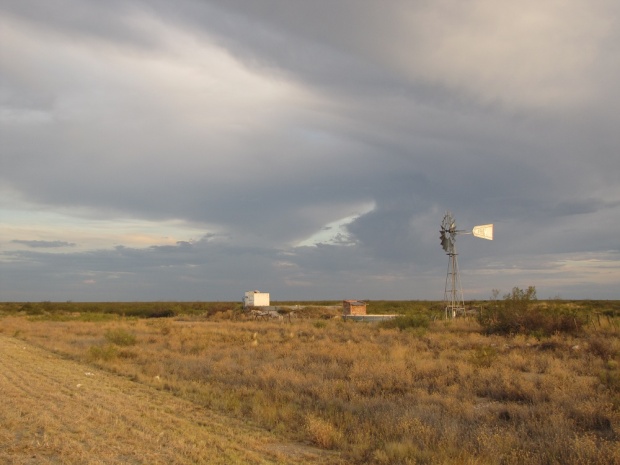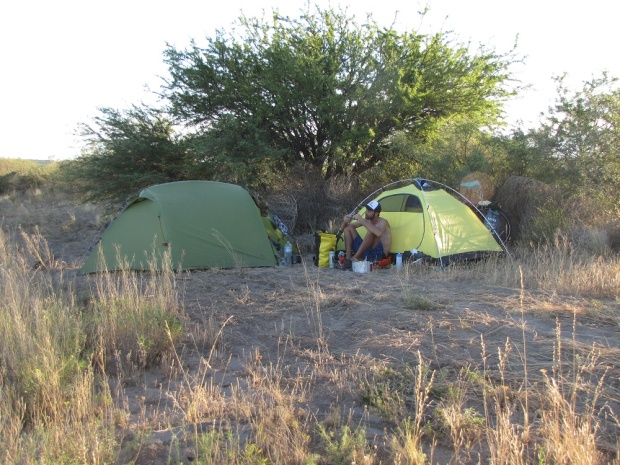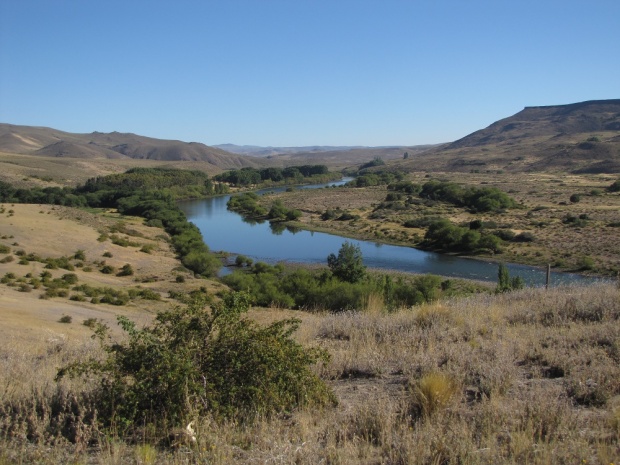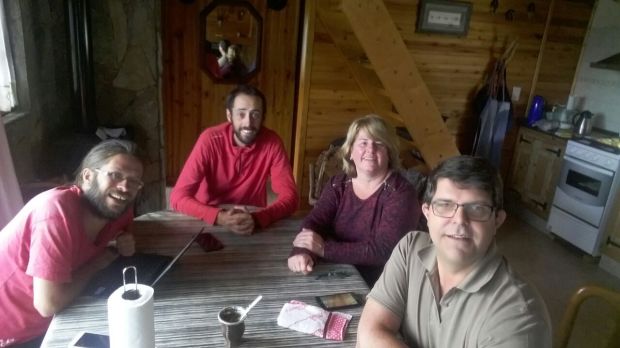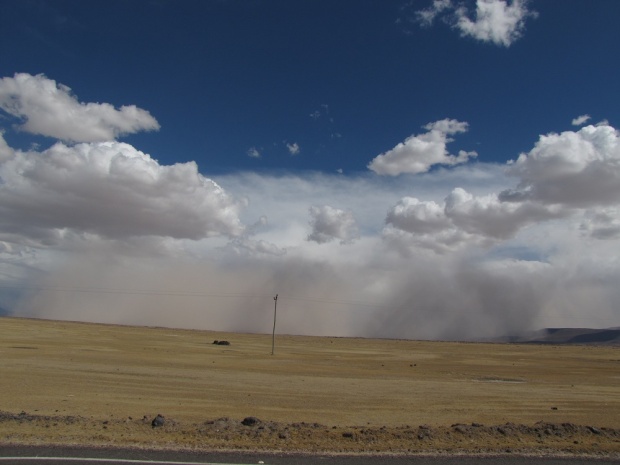I have rolled into San Juan in the early afternoon. Look for a cheap place to sleep, park Lou and then visit all the local shops to find supplies for more than a week. Not counting parking Lou, the tasks were not as simple as they might have appeared at first glance. The fact is that in these small, remote towns it’s not that easy to find an open cheap accommodation in the middle of the day. The owner normally work on fields during the day and only return to their home about an hour before the sunset when all the tourist jeeps stopping for the night arrive.
Still I did manage to find an open “hotel” where could stay for the night. Then shopping. The prices around here are about double what I was paying in the rest of Bolivia. Reason – remoteness of these places. Uyuni, the first decent town is more than 150km away. And all the merchandise comes from there.
I find a shop that has a bit more on offer than the others. I stock up on rice, pasta, instant soups, biscuits and similar. Then I go back to my “hotel”. Tomorrow the second part of this high-altitude tour begins.
For my first day I have chosen a bit longer route that takes me all the way to the border with Chile. But based on the info I managed to collect, this way I can avoid climbing a pass with a bad road leading over it. On the other hand, the road to the border is almost completely flat. The only problem I can see with my plan is, that I’m going west. And the prevailing winds around here are westerly, south-westerly. But they should not be too much of a problem, since they normally pick up only in the afternoon.
Well, that was the plan. Unfortunately nobody told the winds about my plan. On the day of my departure their afternoon started sometime before 9 a.m. That meant it took me more than 10hours (including short stops along the way) to cycle 65km to Avaroa, the border town. There I found refuge for the night in a house under construction. The workers there allowed me to set up my tent in one of the rooms.
Here in Avaroa I had the last chance to opt for an easier way out. Cross the border and descend down in Chile on a paved road. But I have opted out of this option. I turned away from the border and started to climb on a surprisingly nice, well maintained gravel road towards the interior. Towards the junction for the lagoons.

One last look back – Here goes nothing!
After about 30km I came to the point where the route towards the lagoons splits off. Courageously I took the route of dubious quality.

Signpost for cyclists – Seeing this means you are on the right path

The road confirms the signpost
Managing the first pass. Steep, rocky road was done with a lot of pushing. On the other side I’m again faced with the lottery of tracks. Which one to choose?!

Decisons, decisions…
At the end of the day I manage to haul my ass to the shores of the first lagoon. There I’m greeted by Severino, man responsible for maintaining the road. Well, a small stretch of it. The last 5, 10 km and the 10 that are ahead. But more than in his care of the road I’m currently interested if I could use his house as a shelter from the wind to pitch my tent. No problem, but if I want, I can sleep inside his house. His “roommate” has gone today to Uyuni since then ran out of bread and vegetables. He will not be coming back until tomorrow. This has left him with a spare mattresses next to a warm stove inside the house. It didn’t took him long to change my plans!
I park Lou outside and move myself inside. Our supper is a delicious stew that has been brewing on his stove all day long. We finish the day with a nice conversation. It’s nice and warm being inside!

Severino and me
Saying goodbye to Severino, I set off the next day. It’s about 10km to the next lagoons. Takes me more than 2 hours to reach it. Enjoying the shade of an eco-hotel “Los Flamingos” I decide to stay here for the night. It another 40km of mostly sand to the next populated place. That’s a bit too much for today.
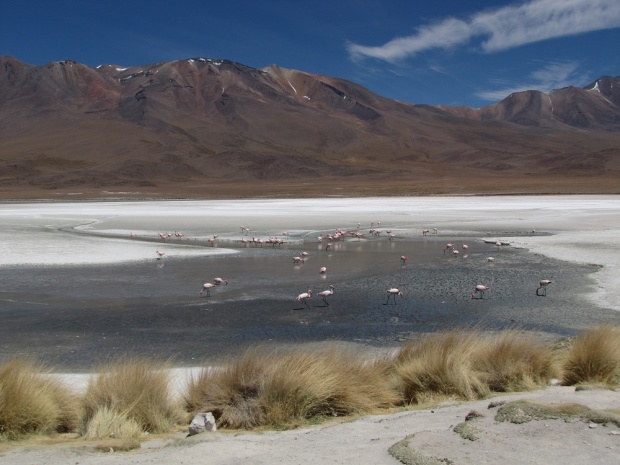
Laguna Hedionda
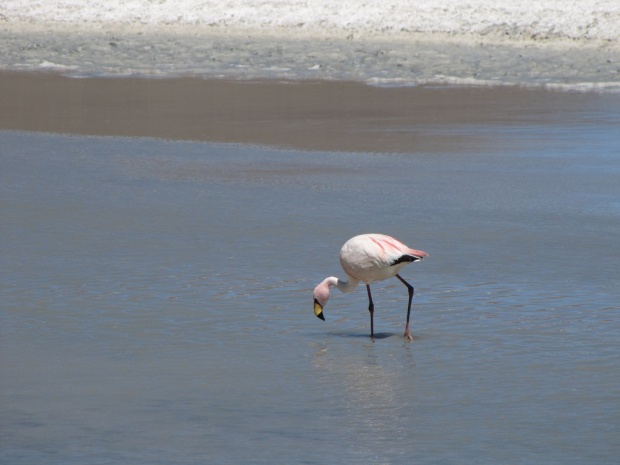
Flamingo
So I befriend Samuel, manager of the hotel. I do ask about the price of a room, but when he mentions 140 USD/night, I only kindly ask if I can pitch my tent in the nearby house under construction. And that’s how the future toilets become my home for the night. I share it with an elderly Australian couple that arrive a bit later on their bicycles.
In the morning the Aussies are in a rush so they roll out at 7h. I take it a bit more easily and so I receive an invitation by the cook to a breakfast. Pancakes, toast, fruits, yoghurt,… Luxury!

Breakfast at Laguna Hedionda
After about 10km I leave the last lagoon behind and the road disappears. What I’m left with is more like a field of 4×4 tracks all leading in the same direction. Some are sandier, others less, but non suitable for cycling. Most of the day I’m left to pushing Lou up a gentle uphill and into headwind. Until I had enough of it a bit past 3 p.m. I head towards a nearby rock formation that should provide me with some shelter. Hopefully this way I will not be blown away, tent and all, during the night. The wind up here is ferocious.

Campsite at 4.600 metres
I sleep with a bottle of water next to me inside the sleeping bag. The rest of the water that I have left outside overnight has turned to ice.
I start day five of the “Ruta de las Lagunas” where I have left off the day before. In sand! Pushing and pushing, seemingly not moving at all.

Sand, sand and more sand

Common sight – Simon pushing his bike
After about 5km the sand is replaced by rocks. Not yet cyclable, but easier to push the bike. That’s how I make it atop another pass. I’m about 10km from Hotel del Desierto, the nearest building that also promises water and shelter for pitching the tent. Maybe even sleeping inside. I will anyhow reach it only by the end of the afternoon, maybe early evening. As it turns out, I have to push Lou even on the downhill as the sand is so deep that even the gravity is left helpless.
I reach Hotel del Desierto about an hour before the sunset. Price of the room – not even worth mentioning – 150 USD/night. But the kind lady at the reception mentions that they make an exception for cyclists and they allow us to sleep in the rooms reserved for the drivers of the tour jeeps. The promise of a hot shower, warm bed and a breakfast that is included in the price, help to convince me that I do not feel like setting up my tent. It looks like that I will anyhow camp tomorrow evening.
So I say goodbye to the day nicely showered, covered with a warm blanket and a few wet clothes drying on the heater. Making the most out of the situation, I use the opportunity of having running water to do some laundry.

High altitude desert
I make the first 10km from Hotel del Desierto half cycling, half walking. Initially my morning choice of the 4×4 tracks looked very promising. But after about 5km they turned into sand and I was returned to the reality of the past 2 days. Off of the bike and pushing towards the horizon that can never be reached. Eventually, after about 3 hours of this torture, I was greeted by a maintained gravel road. For the next 20km I was able to enjoy the fact that I only had to get off the bike sporadically when I came across a sandier patch. Or I was pushed into it by a sudden stronger gust of wind. The road might have been a maintained one, but it has been a while since the maintenance guys have pasted by here.
By the evening I find shelter behind a house of some caretaker who today is not at home. Watching the sunset and observing the game of hide and seek by the shadows and the fading light. The hardest part of the route should be behind me as I have reached the maintained road.

Another day is ending
New day, new curves. After about 5km the descend to Laguna Colorada begins. And again sand, deep sand. At least 80% of the descend I have to push. Lou just sinks in too much. And no, the headwind, that has started again early today, does not help at all. By mid-afternoon I manage do make it to the entrance to the national park. I pay the entrance fee and decide to spend the night in one of the refugios here. A bed for 4 EUR/night, cheap dinner of pasta with tomato sauce. Easy life!
I have decided already yesterday that I will not be climbing almost 5.000 metres high pass laying ahead on this kind of road. True that the actual altitude difference is only about 600 metres since I’m sleeping at 4.400. But based on the info I’m getting from the local drivers, the road to the top is same or very similar shit. Nope, that’s not for me!
So I move towards the entry to the national park and I wait for some tour jeep that could take me at least to the top if not all the way to the first house on the other side. I wait all day in the company of Reynaldo, the park ranger. There is no traffic passing by, so I have time to enjoy a tasty lunch that Reynaldo offers me. And I watch how the wind plays with sand.

Sandstorm over Laguna Colorada
In the late afternoon several jeeps arrive but they are all full and cannot give me a lift. All up until when Omar and Gonzalo come with their tour of 4 backpackers. Since they are not full there is a space for me. Lou and all my equipment go on the roof.
While driving to the summit and chatting with the guys, I manage to find time to look at the road. I’m even happier that they are giving me a lift.
They take me with them all the way to a refugio by the lagoon on the other side where they plan to spend the night. The refugio itself is full so I say goodbye to the company. I manage to persuade Damian, manager of a nearby restaurant, to allow me to unroll my sleeping bag in one corner of the restaurant. I have a headache and I’m feeling sick. After so many kilometres I have done cycling on these altitudes, my body somehow could not accept the fact I have climbed to 5.000 metres that fast. But I’m too tired to be bothered by this. I have a quick dinner, roll into my sleeping bag and fall asleep. Tomorrow is a new day!
In the morning I have all packed up and Lou is ready to depart already by 6 a.m. That is when the first tour jeeps arrive for breakfast. But I do not set off that early. Yesterday Damian told me that if I wait a bit in the morning, I can even get a breakfast. Food that is left over by the tours is worth a fortune to a touring cyclist in these parts. Before setting off Damian and one of the employees give me even more extra food for the road. Time to say goodbye.
Taking into account the local conditions, the road on this side feels like highway. I slowly climb from 4.400 to almost 4.750 metres while constantly turning my head left and right. Every mountain that comes into view seems to be of a different, immensely intensive colour. I did try to take photos, but somehow it seems that the colours and the contrasts on the photos just cannot capture the reality.

Morning mountains 1

Morning mountains 2

Morning mountains 3

Morning mountains 4
After the climb, there is a descend of about 20km. To the other side and the last of the lagoons and a refugio on its shores. Give it is already afternoon, I’m again greeted by the headwind. And not to have it too easy today since I practically have not pushed the bike, I take a “shortcut”. This way I get the chance to again push Lou uphill. As not to forget.
Well tired I make it to the refugio where I get a bed and food. The last port of call before the border. I’m just a gentle 6km uphill away from it. That I leave for tomorrow.
My last day in Bolivia I start easy. Also because while I was yesterday fighting with the wind, I have decided that I will turn right and not left as initially planned at the first junction in Chile. Left would continue to take me through the high mountains to Argentina. And the first sort of decent town in Argentina is about 4-5 days cycling away. Going right, well going right I have about 40km descend to San Pedro de Atacama. Another tourist Disneyland, but exactly because of this even more appealing to me right now. Since if it is a tourist destination, that means there is all the commodity that I have been missing for the past 14 days. Running water, electricity, internet, comfy, cosy bed,… And let’s not to forget to mention, San Pedro is more than 2.000 metres lower and that is well reflected on the temperatures. About 30 degrees during daytime. Isn’t that nice?!
Saying goodbye to Bolivia I roll into Chile. Tarmac! What a luxury!

Goodbye Bolivia

One foot in Chile – Asphalt!

Nice sight – Paved road
After more than 40km downhill into headwind that this time around I’m glad I had since it helped me brake, I make it to Disneyland. Clearing the immigrations I head straight to Sonchek where the owner Mojca, a Slovenian living here for more than 23 years, opens the door.
I’m saved! Well at least for a few days. Argentina is still on the other side of the Andes and it is still where I’m heading to. Let me just first take in the abundance of oxygen and indulge myself in all the comfort.
With a Smile on my face, until next time!
Simon







